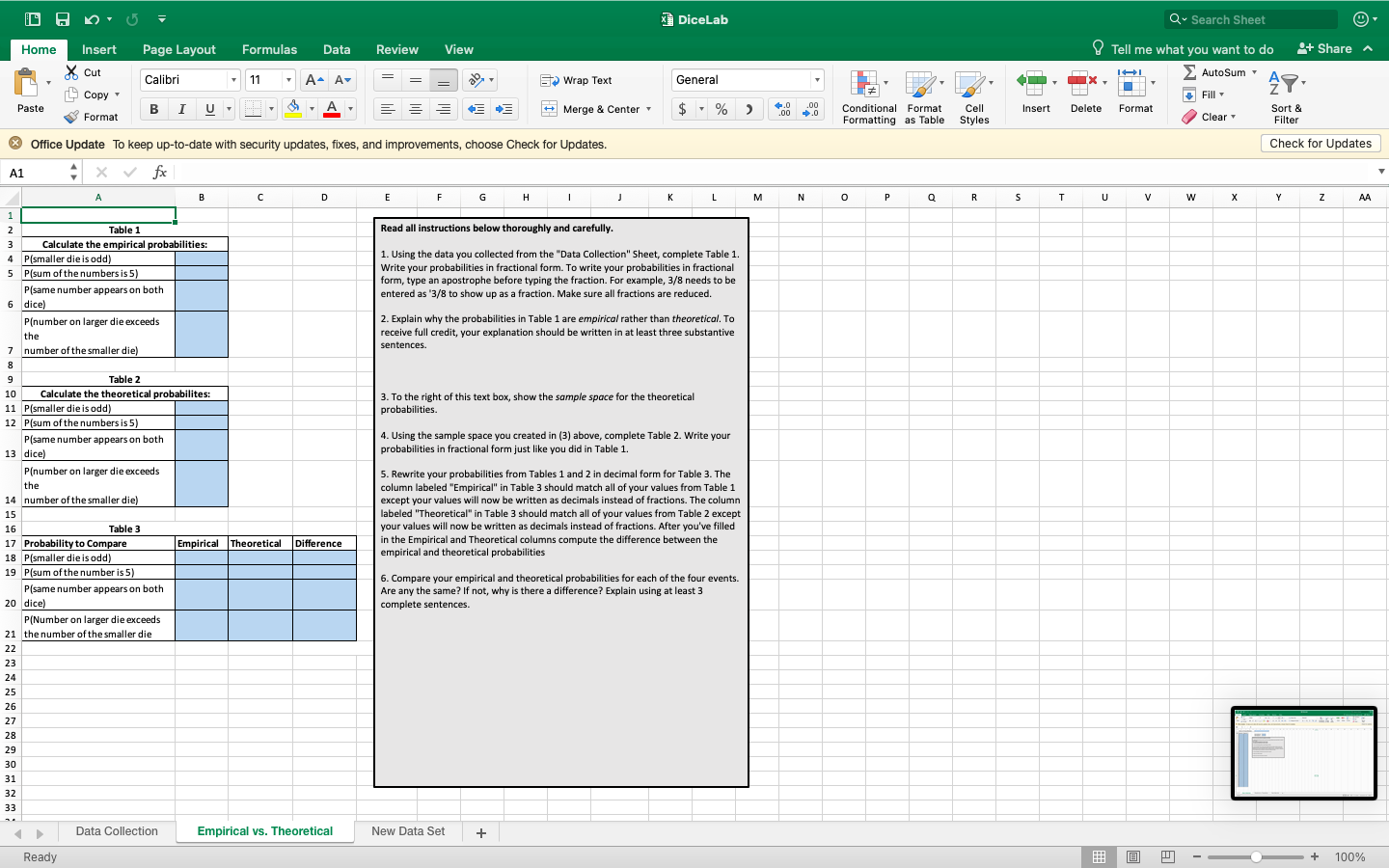DiceLab Q . Search Sheet Home Insert Page Layout Formulas Data Review View Tell me what you want to do + Share Cut Calibri 11 A- A = =1 20- - Wrap Text General X . 2 AutoSum AP. Copy Fill Paste Merge & Center $ % 2 60 $.0 Conditional Format Cell Insert Delete Format Sort & Format Formatting as Table Styles Clear Filter * Office Update To keep up-to-date with security updates, fixes, and improvements, choose Check for Updates. Check for Updates X43 X V J H M N O P a R S w AA AB AC AD AE AG Names of Group Members: Larger Die size of smaller die ize of larger die Read all instructions below thoroughly and carefully. 1. Decide what two dice you want to use for your data collection and record them in cells H4 and HS above. .Your smaller dle should have at least 4 sides. Your larger die should have at least 10 sides. 2. Go to the following website: http://dicelog.com/dice 3. In the cell labeled "Dice to Roll" type Id followed by the number of sides you want your smaller die to have. In the cell labeled "Options" choose "also roll". In the last box type 1d followed by the number of sides you want your larger die to have. For example, if I wanted to & sided die and a 20 sided die I would enter: 1da also roll 1d20 4. In the cell labeled "Roll dice how many times" type 50 5. Click on the "Roll!" button. 6. Enter your rolls in the columns to the left. Data Collection Empirical vs. Theoretical New Data Set + Ready + 76%DiceLab Q . Search Sheet Home Insert Page Layout Formulas Data Review View Tell me what you want to do + Share Cut Calibri 11 A- A = =1 20- - Wrap Text General 2 AutoSum AP. Copy Fill Paste Merge & Center $ ~ % 2 60 $.0 Conditional Format Cell Insert Delete Format Sort & Format Formatting as Table Styles Clear Filter * Office Update To keep up-to-date with security updates, fixes, and improvements, choose Check for Updates. Check for Updates Al X V fx C D G H M N 0 P Q R S T U V w X Z AA Table 1 Read all instructions below thoroughly and carefully. W NI Calculate the empirical probabilities: 4 P (smaller die is odd) 1. Using the data you collected from the "Data Collection" Sheet, complete Table 1. 5 P(sum of the numbers is 5) Write your probabilities in fractional form. To write your probabilities in fractional form, type an apostrophe before typing the fraction. For example, 3/8 needs to be P(same number appears on both entered as '3/8 to show up as a fraction. Make sure all fractions are reduced. 6 dice) P (number on larger die exceeds 2. Explain why the probabilities in Table 1 are empirical rather than theoretical. To the receive full credit, your explanation should be written in at least three substantive 7 number of the smaller die) sentences. co Table 2 10 Calculate the theoretical probabilites: 3. To the right of this text box, show the sample space for the theoretical 11 P(smaller die is odd) probabilities. 12 P(sum of the numbers is 5) P(same number appears on both 4. Using the sample space you created in (3) above, complete Table 2. Write your 13 dice) probabilities in fractional form just like you did in Table 1 P(number on larger die exceeds 5. Rewrite your probabilities from Tables 1 and 2 in decimal form for Table 3. The the column labeled "Empirical" in Table 3 should match all of your values from Table 1 14 [number of the smaller die) except your values will now be written as decimals instead of fractions. The column 15 labeled "Theoretical" in Table 3 should match all of your values from Table 2 except 16 Table 3 your values will now be written as decimals instead of fractions. After you've filled 17 Probability to Compare Empirical Theoretical Difference in the Empirical and Theoretical columns compute the difference between the 18 P(smaller die is odd) empirical and theoretical probabilities 19 P(sum of the number is 5) 6. Compare your empirical and theoretical probabilities for each of the four events. P(same number appears on both Are any the same? If not, why is there a difference? Explain using at least 3 20 dice) complete sentences. P(Number on larger die exceeds 21 the number of the smaller die 22 23 24 25 26 27 28 29 30 Data Collection Empirical vs. Theoretical New Data Set + Ready " - + 100%








